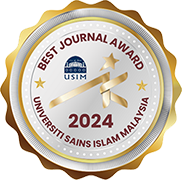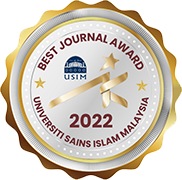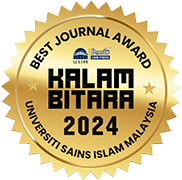THE TRANSFORMATION OF RUKYAH AL-HILAL: INTEGRATING DIGITAL IMAGING TECHNOLOGY IN ISLAMIC MOON SIGHTING PRACTICES
DOI:
https://doi.org/10.33102/mjsl.vol13no1.751Keywords:
Rukyah, rukyah al-hilal, digital imaging, Islamic month, Islamic lawAbstract
Rukyah is a method used to ascertain the start of the Islamic month by observing the sight of the new moon. The purpose of this study is to examine the transformation of traditional rukyah al-hilāl practices with the integration of modern technological tools, specifically digital imaging and telescopes. By analysing classical and contemporary Islamic scholarly perspectives, this research seeks to evaluate how these technological advancements impact the process of moon sighting, which is central to determining the Islamic calendar. The methodology employed in this study is qualitative, utilising a comparative analysis of classical juristic texts from scholars. Data was collected through literature review and analysis of relevant fatwas and scholarly discussions on the permissibility and effectiveness of technological aids in rukyah al-hilāl. The results indicate a clear transformation in the acceptance of technology, with contemporary scholars endorsing the use of telescopes and digital imaging to enhance the accuracy and reliability of moon sighting. While classical scholars acknowledged the use of basic visual aids, they emphasised the importance of direct visual observation. This study is original in its comprehensive examination of how Islamic jurisprudence is adapting to modern technological developments in moon sighting, an area that has not been extensively studied. The implications of this research are significant for Islamic legal institutions, as it provides a framework for integrating technology into religious practices while maintaining alignment with the principles of Islamic jurisprudence. It also highlights the potential for further advancements in the field, paving the way for future discussions on the intersection of faith and science.
Downloads
References
‘Azzām, A. al-‘Azīz, M. (2013). Al-qawā‘id al-fiqhiyyah. Dār al-Ḫadīṡ.
Ahmad Warson Munawwir. (1997). Al-Munawwir: Kamus Arab-Indonesia. Pustaka Progresif.
Alfitri. (2020). Bureaucratizing fatwā in Indonesia: The Council of Indonesian Ulama and its quasi-legislative power. Ulumuna, 24(2), 367–397. https://doi.org/10.20414/ujis.v24i2.412
Al-Jauziyah, I. Q. (n.d.). I’lamul muwaqi’in ’an rab al-‘alamin. Dār al-Fikr.
Anwar, S. (2016). Unified Islamic calendar in the perspective of Islamic legal philosophy. Al-Jami’ah, 54(1), 203–247. https://doi.org/10.14421/ajis.2016.541.203-247
Bruin, F. (1977). The first visibility of lunar crescent. Vistas in Astronomy, 21, 331–358
Endarto, D. (2005). Pengantar kosmografi. Lembaga Pengembangan Pendidikan UNS bekerjasama dengan UNS Press.
Hakim, C. F. Y., & Basyir, A. (2004). Hisab rukyat dan perbedaannya. Proyek Peningkatan Pengkajian Kerukunan Hidup Umat Beragama, Puslitbang Kehidupan Beragama, Badan Litbang Agama dan Diklat Keagamaan, Departemen Agama RI.
Hazrazil, & Lewa, I. (2021). Return of stored goods: Comparative analysis of the laws between the al-Shafi’i and the Hanafi school. Mazahibuna: Jurnal Perbandingan Mazhab, 3(2), 171–180. https://doi.org/10.24252/mh.v3i2.22272
Khaera, N., Rahman, A., & Kurniati. (2022). The paradigm of Islamic legal products in Indonesia: A critical review of the polarization of the characteristics and authority of the madhhab of thought products. Mazahibuna: Jurnal Perbandingan Mazhab, 4(1), 31–48. https://doi.org/10.24252/MH.VI.26364
Khaleel, F. (2016). Redefining poverty and its measurement: An Islamic political economy perspectives. Global Review of Islamic Economics and Business, 4(2), 68-81. https://doi.org/10.14421/grieb.2016.042-01
Legault, T. (2013). Astrophotography. Groupe Eyrolles.
Ma’luf, L. (1989). Al-munjid fī al-lughah wa al-a‘lām. Dār al-Masyriq.
Manzûr, I. (n.d.). Lisān al-‘Arab (17th ed.). Dār al-Ma‘ārif.
Masroerie, A. G. (2011). Penentuan awal bulan qamariyah. Lajnah Falakiyah Nahdlatul Ulama.
Mehmood, M. I., & Hashim, N. B. M. (2021). Marriage without wali’s consent: A paradigm shift in the family structure of Pakistan. IIUM Law Journal, 29(S1), 135–151. https://doi.org/10.31436/iiumlj.v29i(s1).639
Minnett, P. J., Alvera-Azcárate, A., Chin, T. M., Corlett, G. K., Gentemann, C. L., Karagali, I., Li, X., Marsouin, A., Marullo, S., Maturi, E., Santoleri, R., Saux Picart, S., Steele, M., & Vazquez-Cuervo, J. (2019). Half a century of satellite remote sensing of sea-surface temperature. Remote Sensing of Environment, 233, 111366. https://doi.org/10.1016/j.rse.2019.111366
Mufid, A., Zaiyadi, A., Nabawiyah, H., & Fasa, M. I. (2020). Unification of global hijri calendar in Indonesia: An effort to preserve the maqasid sunnah of the Prophet (SAW). Journal of Islamic Thought and Civilization, 10(2), 18–36. https://doi.org/10.32350/jitc.102.02
Muhdlor, A. A., & Zain, A. (1998). Kamus kontemporer Arab-Indonesia. Multi Gaya Grafika.
Mustaqim, R. A. (2020). Transformation of rukyatul hilal method (Postmodernism analysis of hilal image processing). Al-Hilal: Journal of Islamic Astronomy, 1(1), 37-52. https://doi.org/10.21580/al-hilal.2019.1.1.5238
Niedermeier, A. (2020). Review of Powell, Emilia (2020): Islamic law and international law: Peaceful resolution of disputes. Oxford University Press. Review of Economics and Political Science, 5(4), 335–355. https://doi.org/10.1108/REPS-08-2020-0128
Nisa’, I. N. F., & Ulinnuha, M. (2021). Ittihad and ikhtilaf al mathla’: Discourse and its implementation. Al-Hilal: Journal of Islamic Astronomy, 3(2), 19–42. https://doi.org/10.21580/al-hilal.2021.3.2.8120
Purwanto. (1992). Visibilitas hilal sebagai acuan penyusunan kalender Islam. Institut Teknologi Bandung.
Rachmadhani, F., Sahid, M. M., & Ichsan, M. (2024). The use of sadd al-dharī‘ah in contemporary Islamic family law in Indonesia: Concept and practice. Malaysian Journal of Syariah and Law, 12(1), 206–215. https://doi.org/10.33102/mjsl.vol12no1.505
Raharto, M. (2004). Teknologi optik sebagai pembantu penetapan awal bulan Hijriyah/Qamariyah. In C. F. Yusuf & B. A. Hakim (Eds.), Hisab rukyat dan perbedaannya. Proyek Peningkatan Pengkajian Kerukunan Hidup Umat Beragama, Puslitbang Kehidupan Beragama, Badan Litbang Agama dan Diklat Keagamaan, Departemen Agama RI.
Schaefer, B. E. (1991). Length of the lunar crescent. Quarterly Journal of the Royal Astronomical Society, 32, 265–277.
Syatar, A., Bakry, M., Bedong, M. A. R., Pallawagau, B., Parepare, I., & Kendari, I. (2023). The development of fatwas based on local wisdom to the national level: A case study of panaik money fatwa. El-Mashlahah, 13(2), 133–150. https://doi.org/10.23971/el-mashlahah.v13i2.7373
Tabran, M., & Talli, A. H. (2021). Talqīn for the dead before and after burial: An analysis of the al-Shafi’i and Maliki schools of thought. Mazahibuna: Jurnal Perbandingan Mazhab, 3(2), 130–141. https://doi.org/10.24252/mh.v3i2.22003
Thomas Djamaluddin, Muhammad Husni, & Sunaijo. (2010). Hisab rukyat di Indonesia serta permasalahannya. Badan Meteorologi Klimatologi dan Geofisika.
Tono Saksono. (2007). Mengkompromikan rukyat & hisab. Amythas Publicita.
Wijaya, A., & Muzammil, S. (2021). Maqāṣidi tafsir: Uncovering and presenting maqāṣid ilāhī-Qur’anī in contemporary context. Al-Jami’ah: Journal of Islamic Studies, 59(2), 449–478. https://doi.org/10.14421/ajis.2021.592.449-478
Downloads
Published
Issue
Section
Categories
License
Copyright (c) 2025 Muhammad Rasywan Syarif, Sakirman, Abdul Syatar, Nur Lela

This work is licensed under a Creative Commons Attribution-NonCommercial 4.0 International License.














































